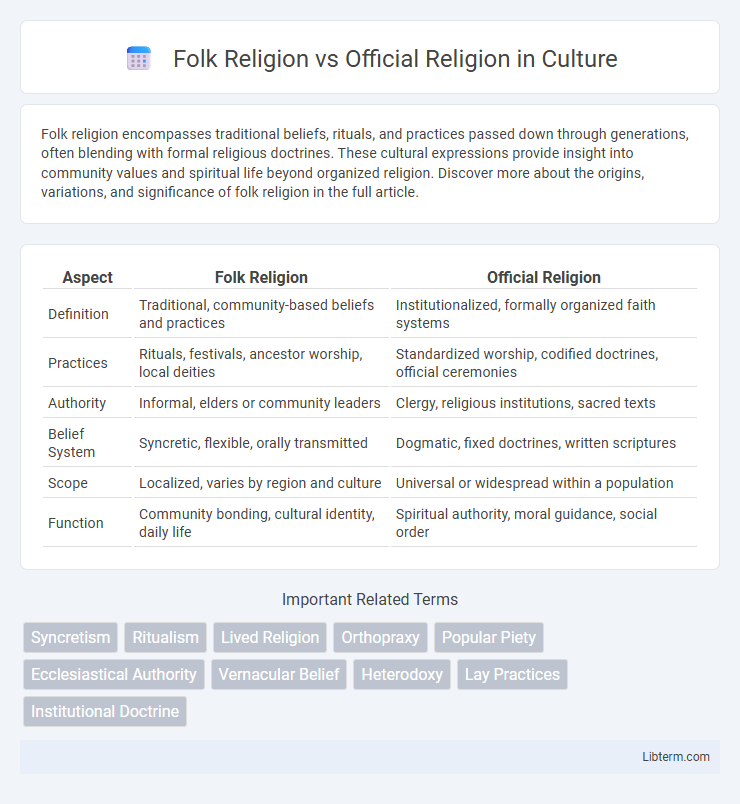Folk religion encompasses traditional beliefs, rituals, and practices passed down through generations, often blending with formal religious doctrines. These cultural expressions provide insight into community values and spiritual life beyond organized religion. Discover more about the origins, variations, and significance of folk religion in the full article.
Table of Comparison
| Aspect | Folk Religion | Official Religion |
|---|---|---|
| Definition | Traditional, community-based beliefs and practices | Institutionalized, formally organized faith systems |
| Practices | Rituals, festivals, ancestor worship, local deities | Standardized worship, codified doctrines, official ceremonies |
| Authority | Informal, elders or community leaders | Clergy, religious institutions, sacred texts |
| Belief System | Syncretic, flexible, orally transmitted | Dogmatic, fixed doctrines, written scriptures |
| Scope | Localized, varies by region and culture | Universal or widespread within a population |
| Function | Community bonding, cultural identity, daily life | Spiritual authority, moral guidance, social order |
Understanding Folk Religion: Key Characteristics
Folk religion encompasses localized beliefs and practices rooted in tradition, often blending animism, ancestor worship, and ritual magic distinct from formal doctrine. It operates through oral transmission and community participation, emphasizing personalized spirituality rather than centralized ecclesiastical authority. This form of religion adapts dynamically to cultural contexts, preserving indigenous customs often marginalized by official religious institutions.
Defining Official Religion: Structures and Doctrines
Official religion is characterized by formal structures and codified doctrines established by authoritative institutions, often endorsed or mandated by the state. These religions maintain organized clergy, standardized rituals, and official texts guiding belief systems and practices. The emphasis on hierarchical governance and doctrinal uniformity distinguishes official religion from more fluid and localized folk religious expressions.
Historical Evolution of Folk and Official Religions
Folk religion often predates and persists alongside official religions, evolving through localized rituals, ancestor worship, and animistic practices deeply rooted in cultural traditions. Official religions, formalized by state or institutional endorsement, emerged historically to unify societies under centralized religious doctrines and hierarchical clergy systems. Over time, folk religions influenced official religious practices by integrating local customs, while official religions sometimes suppressed or adapted folk elements to maintain social order and political power.
Ritual Practices: Comparing Folk and Official Traditions
Folk religion rituals emphasize local customs, ancestral worship, and community participation, often conducted informally without centralized authority. Official religion rituals follow standardized liturgies established by religious institutions, involving clergy and formal ceremonies with doctrinal consistency. The divergence in ritual practices highlights the contrast between personalized, evolving folk traditions and codified, uniform official rites.
Authority and Leadership: Who Guides the Faithful?
Folk religion is typically guided by local elders, shamans, or community leaders who hold authority based on tradition and personal spiritual experience, rather than formal institutions. Official religion is led by established clergy or religious hierarchies, such as priests, bishops, or imams, who derive their authority from codified doctrines and centralized organizations. Leadership in folk religion is often fluid and decentralized, contrasting with the rigid, institutionalized authority structures in official religions.
Syncretism: Where Folk and Official Religions Meet
Syncretism represents the blending of folk religion and official religion, where traditional beliefs and practices merge with formal doctrines to create hybrid spiritual expressions. Folk rituals, often rooted in local culture and ancestral customs, integrate symbols, festivals, and deities from organized religions, enriching communal identity and worship styles. This fusion fosters dynamic religious landscapes, reflecting adaptability and continuity within diverse societies worldwide.
Social Functions and Community Roles
Folk religion serves as a vital social function by preserving cultural heritage and reinforcing communal identity through rituals, festivals, and oral traditions embedded in everyday life. Official religion often institutionalizes beliefs with formal doctrines and clerical hierarchies, promoting social cohesion and normative moral values on a broader societal scale. Together, these religious forms shape community roles by balancing personal spirituality with organized worship, sustaining social order, and fostering collective solidarity.
Adaptability and Resilience in Folk vs Official Religion
Folk religion exhibits high adaptability and resilience by integrating local customs, beliefs, and rituals that evolve organically within communities, allowing it to persist despite socio-political changes. Official religion tends to be more rigid, often codified with centralized doctrines that resist rapid change and prioritize uniformity over local variations. This flexibility in folk religion facilitates continuous cultural relevance and survival, even under the pressures of modernization and institutional regulation.
Conflict, Coexistence, and Integration
Folk religion often conflicts with official religion due to differences in rituals, beliefs, and authority, leading to social tension and resistance from religious institutions. Despite conflicts, many communities experience coexistence where folk practices persist alongside formal doctrines, allowing cultural traditions to thrive without fully challenging official religious frameworks. Over time, integration occurs as elements of folk religion are incorporated into official religious practices, resulting in hybrid forms that reflect both local customs and institutional beliefs.
Contemporary Relevance: The Future of Folk and Official Religions
Folk religions persist globally by adapting to local customs and social changes, maintaining cultural identity amidst modernization. Official religions, often institutionalized and doctrinally rigid, face challenges integrating folk practices while retaining authority and relevance. The future likely holds syncretic religious expressions blending official doctrines with folk traditions, reflecting dynamic responses to globalization and shifting spiritual needs.
Folk Religion Infographic

 libterm.com
libterm.com